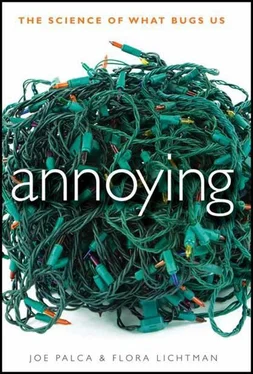The other extreme is rising above the annoyance—not letting it get to you in the slightest. Even when the consequences are not that great, certain professions require people to try to do this. We may be able to learn from this skill. The same techniques that professionals use to shut out the annoyances of life may be of use to the rest of us in doing the same.
If you’re a baseball fan, you know exactly what we mean when we say that Joba Chamberlain has lived Chris Joyce’s nightmare, the sports equivalent of missing his rendezvous with a beautiful girl.
It was an unseasonably warm night for October in Cleveland, 81 degrees when the game began. That’s not a corny, color lead; that unseasonable warmth is an important detail. A breeze was blowing from Lake Erie toward home plate at Jacobs Field for game two of the 2007 American League Divisional Series between the New York Yankees and the Cleveland Indians. The Indians had demolished the Yankees the night before in game one, scoring twelve runs on fourteen hits.
Game two was a different story. Yankee veteran pitcher Andy Pettitte gave up six hits in the first six innings but somehow never allowed the Indians to put a rally together. Cleveland pitcher Fausto Carmona was sharper, allowing just two hits through six, but one of those hits was a solo home run by Yankee center fielder Melky Cabrera.
Pettitte started the seventh inning with a one-run lead. The first batter, Ryan Garko, fouled out to first base. Then Cleveland shortstop Jhonny Peralta doubled, followed by a walk to left-fielder Kenny Lofton, putting the potential go-ahead run on base. Yankees manager Joe Torre had seen enough. He signaled to the bullpen for young phenom pitcher Joba Chamberlain.
Chamberlain was just twenty-two years old. He had appeared in only nineteen major league games, but the hard-throwing rookie was on an incredible roll. In the twenty-four innings he had pitched for the Yankees during the regular season, he had struck out thirty-four of the seventy-eight batters he’d faced and had allowed only one earned run. He had electric stuff, was unhittable really, and many saw in him a future superstar. So Torre decided to roll the dice and see whether his budding superstar was up to preserving the Yankees’ lead.
At first, Torre’s confidence in Chamberlain seemed justified. He struck out Indians pinch-hitter Franklin Gutierrez on three pitches. It took only two pitches to induce the next batter to pop out to right field. The score remained 1–0 after seven innings. When Chamberlain returned to the mound at the start of the eighth inning, however, he had to face an annoyance of epic proportions. A swarm of insects descended on Jacobs Field.
According to the Associated Press, the insects were gnatlike creatures known as midges. They might have been the nonbiting midge known as Chironomus plumosus or possibly its close, nonbiting cousin Chironomus attenuatus . The AP writer wasn’t clear on this point. “‘Non-biting midges are small (1/8-inch to 1/2-inch long), delicate, mosquito-like, but lack scales on their wings,’ declares the Ohio State University Extension Fact Sheet on midges and crane flies. It continues, ‘Adults are humpbacked, brown, black, orange, or gray, lack a long beak (proboscis), and males have very feathery antennae.’”
Even if a magnifying glass had been handy, Chamberlain would not have been likely to appreciate the midges’ feathery antennae and scale-free wings at that particular moment. All he was conscious of was that these bugs were everywhere. What the midges lack in their ability to annoy people with an itchy bite, they make up for in sheer numbers. “Probably millions of them,” says David Denlinger, an entomologist at Ohio State University. October is late in the year to see swarms of midges, but the proximity of Lake Erie to the stadium and the warm temperatures at game time probably explain the unseasonable swarm.
“Those are basically mating swarms,” says Denlinger. “The major composition of that swarm is probably going to be males looking for mates. And then the females will enter the swarm and get mated, and they don’t hang around very long.”
No doubt, the ball players wished that the males had the good sense to leave, too, once the party was over—but they didn’t. “During my at bat, I had them in my nose,” said Yankees first baseman Doug Mientkiewicz. Even viewers at home found it hard to watch on TV, because the midges seemed to be covering every part of every player in every shot. It seemed like some kind of biblical plague.
Baseball is famously a game of inches, and with a tiny white ball whistling past hitters at up to a hundred miles an hour, it’s also a game of milliseconds. In fact, the official MLB rules about what a pitcher can wear on the mound are very exacting, so that the flash of a sleeve can’t unfairly distract the batter. The space in centerfield behind the pitcher—referred to as the batter’s eye—is always black, and fans aren’t allowed in that part of the park, so that movement and color hundreds of feet away from the batter can’t interfere with his ability to see the pitch. Now Mother Nature had filled the batter’s eyeball with crawling, horny insects.
No one was happy with the situation. The Yankees infielders were waving their caps and gloves, trying to shoo away the flying midges. The Cleveland batters looked equally uncomfortable. And the midges were probably wishing that big galoots like Chamberlain would get out of their way so they could continue their hot pursuit of love.
Chamberlain seemed particularly irritated and uncomfortable. “Joba had them all over his back and all over his neck and all over everywhere,” said his teammate Mientkiewicz. The umpires weren’t about to come to his rescue. “It was just a little irritation,” said umpire crew chief Bruce Froemming. “We’ve had bugs before. I’ve seen bugs and mosquitoes since I started umpiring.” To Froemming, it might have been a little irritation. Unfortunately for Chamberlain, the midges got under his skin, so to speak. He walked Grady Sizemore on four pitches. Then he threw a wild pitch to Asdrubal Cabrera. Sizemore to second. Cabrera laid down a sacrifice bunt. Sizemore to third. A glimmer of hope when Travis Hafner lined out, but then another wild pitch, this time to Victor Martinez. Sizemore home. Game tied.
The Indians went on to win in the eleventh inning in what is officially known as the Bug Game. “They bugged me, but you’ve got to deal with it,” said an irritated Chamberlain after the game.
Mark Aoyagi is a sports psychologist at the University of Denver, and he knows that’s easier said than done. According to him, it’s simply not possible to actively ignore something that’s irritating you. You have to take another approach. In Chamberlain’s case, Aoyagi says that the young pitcher “can’t not focus on the bugs.” In other words, if he tries not to focus on the bugs, he will just focus on them more. The trick, says Aoyogi, is to focus on something else. In Chamberlain’s case, Aoyagi says, “The batter, the game, the situation, the catcher’s mitt, all those relevant variables. It’s not that you’re trying to block anything out so you won’t focus on the bugs; it’s that you choose to focus on what’s relevant.”
In a way, Aoyagi is arguing for putting something that psychologists call inattentional blindness to good use. The idea is that you can miss things that are literally right under your nose if your attention is focused on something else. In a famous article on the topic, Dan Simons of the University of Illinois described inattentional blindness this way:
Perhaps you have had the following experience: you are searching for an open seat in a crowded movie theater. After scanning for several minutes, you eventually spot one and sit down. The next day, your friends ask why you ignored them at the theater. They were waving at you, and you looked right at them but did not see them. {24} 24 1. Daniel J. Simons and Christopher F. Chabris, “Gorillas in Our Midst: Sustained Inattentional Blindness for Dynamic Events,” Perception 28 (1999): 1059–1074.
Читать дальше












